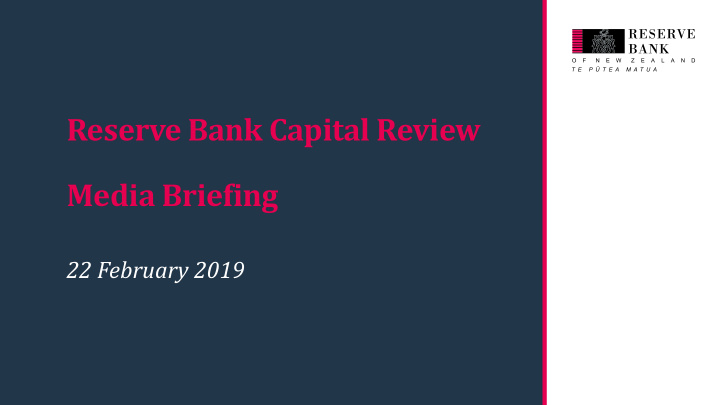



Reserve Bank Capital Review Media Briefing 22 February 2019
Housekeeping • Briefing material embargoed until 4pm today – at media’s request. • Draft speech provided under embargo. Final text released at 12.30pm on Tuesday 26 th. • Time for questions at the end. • Media and Reserve Bank people on videoconference from Auckland. 2
Opening remarks: Geoff Bascand 3
What we’re trying to achieve • Stronger banks and stronger banking system - better able to survive large shocks. • Protect New Zealand from the significant harm that accompanies a banking crisis. • Protect depositors and potentially taxpayers from failing banks. • Maintain investor confidence in New Zealand’s banking system. 4
A more level playing field • Current Tier 1 capital per $100 of mortgage lending, Tier 1 capital at proposed minimum ratios (estimate using publicly available data) $ $ 7 7 Current outcome Proposed minimum (estimate) 6 6 5 5 4 4 3 3 2 2 1 1 0 0 5 ANZ ASB BNZ Westpac Kiwibank Other banks
Why we care • The Reserve Bank’s job is to promote a sound and efficient financial system. • If a bank fails, then all of society suffers – not just the bank’s customers. • Our tolerance of bank crises has reduced given evidence of enduring, wide-ranging crisis impacts. • We want banks to have enough capital, and the right quality capital, to withstand significant shocks. • More capital reduces the likelihood of a bank failure. 6
What will it mean for society? • Banks will be safer – the costs and risks of a bank failure are reduced. • Interest rates (borrowing and lending) could change – but we don’t expect by much. Lending margins above borrowing cost may expand by 20-40 basis points. • Banks make profits from lending. The competitive market will continue and if one bank pulls back in a particular segment of lending, we expect another will step up. • 20 banks operate in NZ, with 16 in the retail market. 7
What does it mean for banks? • More and better-quality capital. So that means banks will be safer – so will likely get cheaper credit. • The big four banks would have five years to increase their capital ratio from the current 12% to 16%. We expect a combined increase in capital of around $20bn for the big four. • Other banks have to increase their capital ratio from the current average of 14% to 15%. We expect a combined increase of around $0.9bn in capital for these banks. 8
Clarity on regulator-regulated relationship • More efficient model approval process. • Escalated Supervisory Response (ESR) – greater clarity about supervisory actions with a graduated buffer approach. 9
What will banks do? • Banks will keep making their own decisions about how they manage their balance sheets. They have a number of options to raise the capital they need. • They could retain more profits over several years (rather than paying out dividends to their owners) or they could raise more capital from shareholders. • We estimate the big four banks could get there by retaining 70% of their net earnings over 5 years. • The small bank sector might take a bit longer, around 7 years. 10
International comparison – Basel Committee • Limitations: NZ application of Basel framework on average is more conservative than other jurisdictions. Peer group includes banks with less comparable business models to 11 NZ banks.
International comparisons – S&P S&P Risk- 18 18 Adjusted Capital 16 16 ratio (%) 14 14 12 12 10 10 8 8 6 6 4 4 Range Median 2 2 0 0 FI NO CZ NZ SE HK DK PL IE NL MY IL AU AT SG NZ (p) • Limitation: Standard and Poor’s Risk-Adjusted Capital methodology relies on S&P’s economic risk assumptions 12 (Peer group: 4 largest NZ banks, large retail and commercial banks in each country; NZ (p) = pro forma)
Proposed transition Quarter / year Proposal • Confirm final Capital Ratio decisions Q3 2019 • New AT1 instruments need to meet revised standards • Start of transition to higher ratios Q4 2019 • Implement changes to IRB framework (floor / scalar) • Dual reporting • Revised Standardised Measurement Approach (Op Risk) 2020 • Leverage ratio requirements • Transition to higher capital ratios 2021 2022 • Transition to higher capital ratios 2023 2024 13
Timeline – near term • Speech from Deputy Governor Geoff Bascand (26 Feb). • Another industry forum penciled in, Auckland (March). • Analytical note on Risk Appetite Framework (March). • Open to further discussions with industry during the consultation period, including bilateral meetings if desired. • Consultation closes (3 May). • Reserve Bank publishes submissions (June). • Release of final decisions, accompanied by Regulatory Impact Statement (Q3). 14
Further work • Consultation on further elements of the framework: Near term: – Identification framework for systemically important banks (March). – Internal model change process (workshop with affected banks). Later in 2019 and beyond: – Mutual capital instrument. – Leverage ratio design (if decision made to proceed). – Escalating Supervisory Response framework and trigger points. – Strategy for setting the countercyclical capital buffer. – Operational risk framework (pending APRA finalisation). – Tier 2 (subject to current consultation). • Dovetail with changes to Banking Supervision Handbook as Capital Review decisions are implemented. 15
Questions ? 16
Recommend
More recommend